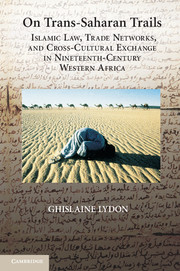 On Trans-Saharan Trails
On Trans-Saharan Trails Book contents
- Frontmatter
- Contents
- Acknowledgments
- Note on Language
- List of Abbreviations
- Glossary
- Maps
- 1 “Making History” Across the African Divide
- 2 Trans-Saharan Trade in the Longue Durée
- 3 Markets and the Movement of Caravans: Nineteenth-Century Developments
- 4 Guelmīm and the Wād Nūn Traders
- 5 The Organization of Caravan Trade
- 6 Business Practice and Legal Culture in a Paper Economy of Faith
- 7 Trade Networks and the Limits of Cooperative Behavior
- 8 On Trans-Saharan Trails
- Appendix 1 Nineteenth-Century Events
- Appendix 2 Pillaged Caravans Reported in the Chronicles
- Bibliography
- Index
2 - Trans-Saharan Trade in the Longue Durée
Published online by Cambridge University Press: 02 July 2009
- Frontmatter
- Contents
- Acknowledgments
- Note on Language
- List of Abbreviations
- Glossary
- Maps
- 1 “Making History” Across the African Divide
- 2 Trans-Saharan Trade in the Longue Durée
- 3 Markets and the Movement of Caravans: Nineteenth-Century Developments
- 4 Guelmīm and the Wād Nūn Traders
- 5 The Organization of Caravan Trade
- 6 Business Practice and Legal Culture in a Paper Economy of Faith
- 7 Trade Networks and the Limits of Cooperative Behavior
- 8 On Trans-Saharan Trails
- Appendix 1 Nineteenth-Century Events
- Appendix 2 Pillaged Caravans Reported in the Chronicles
- Bibliography
- Index
Summary
West Africa has well established and highly organized external commercial links across the desert and the ocean. These highways, though slow and hazardous, connected the region to the international economy centuries before the industrial revolution enabled the major European powers to increase their penetration …
Anthony G. HopkinsIt is more profitable and more advantageous [for the trader] … to export his products to a distant land and take a dangerous route. In this way, the distance and the risk incurred will give a rare quality to his merchandise, and thereby increase its value. … This is why the wealthiest and most prosperous merchants are those who dare to go to the Sudan.
ʿAbd al-Raḥmān Ibn KhaldūnIn the fifteenth century, before the arrival of Portuguese caravels on the western shores of Africa, caravans circulated between Timbuktu, the famed city of present-day Mali, and the markets of the northern desert edge. They transported primarily gold, ivory, tanned leather, and enslaved Africans, which were exchanged for copper, cowries, salt, and other goods. One such northern market was the burg of Tamentit, located in the oasis of Tuwāt, considered then the “Gateway to the Bilād al-Sudān.” When the Genoese merchant Antonius Malfante sojourned there in 1447, he explained in a letter to his Italian associate that his host and main informant, who presumably was a Muslim, was a retired trans-Saharan merchant. He had resided in Timbuktu for thirty years before eventually returning home, leaving his brother there to trade in his place.
- Type
- Chapter
- Information
- On Trans-Saharan TrailsIslamic Law, Trade Networks, and Cross-Cultural Exchange in Nineteenth-Century Western Africa, pp. 49 - 106Publisher: Cambridge University PressPrint publication year: 2009


